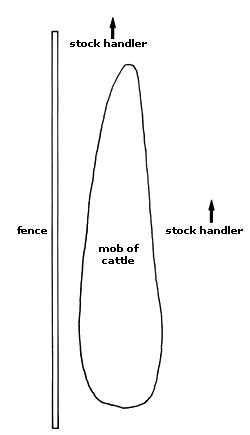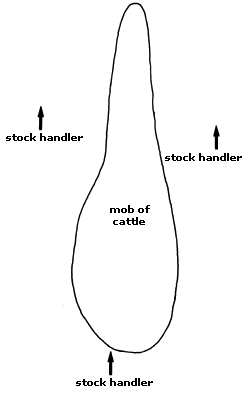
Handling Bos indicus cattle
To handle cattle successfully, especially Bos indicus breeds, it is necessary to understand how they react to people and situations, and to educate them to accept handling.
Stock handler safety
All cattle are potentially dangerous to a handler if adequate precautions and care are not practised.
It is important that handlers bear in mind at all times that animals, in particular large animals like cattle, can cause serious injury. Injury to the handler can often be unintentional on the animal’s behalf, or due to inexperience on the handler’s behalf. Being aware that injury can occur, taking appropriate cautionary measures and noting escape routes should be considered at all times.
This Agfact is aimed at increasing the skill of stock handlers and hence reducing the risk of injury to both handler and animal.
Understanding the animal’s reactions
The most important aspect of handling any livestock is being able to recognise and understand an animal’s reactions. A beast’s ‘body language’ will indicate if it is feeling threatened by, for instance, the handler standing too close, making sudden movements or loud noises, jamming it too tightly, or isolating it in the yards. Cattle also react to a handler approaching in an unfamiliar way. A good handler watches cattle, recognises their reactions and gains their confidence by settling them down so they don’t try to break away.
In many ways, Bos indicus cattle react like horses:
- When frightened, their natural instinct is to escape.
- They are very curious—even after being frightened they will often return for another look.
- They react favourably to good handling, kindness and particularly feed.
- They don’t like to be singled out either in yards or in the paddock. A beast breaking from the mob will run if chased. If left alone it will usually return to the mob. Cutting cattle out in the paddock, apart from teaching them bad habits, can be fruitless if they are able to rejoin the mob.
- They are frightened by strange surroundings and noises.
- Bulls will sometimes guard their cows like a stallion guards his mares—driving them together and keeping intruders away. Sometimes bulls will do their best to prevent the herd being driven to the yards, so that it may be necessary to yard bulls with a few cows before trying to yard the herd.
- Cows can be very protective of young calves, so handling them in the presence of their mothers can be dangerous.
- They travel freely and like to string out following a leader.
Training
It is essential that Bos indicus cattle be taught to do what you want them to do. Every time the cattle are handled, the type of handling should fit into an overall training plan. Bos indicus cattle become accustomed to the way in which they are mustered and worked through yards. You should therefore develop the best procedure for mustering each paddock and working stock in the yards, and then stick to it. The best time to educate cattle is at weaning.



It is essential that Bos indicus cattle be taught to do what you want them to do. Every time the cattle are handled, the type of handling should fit into an overall training plan. Bos indicus cattle become accustomed to the way in which they are mustered and worked through yards. You should therefore develop the best procedure for mustering each paddock and working stock in the yards, and then stick to it. The best time to educate cattle is at weaning.
Yard weaning
Yard weaning over a period of 7–14 days is by far the best way of producing manageable cattle. The only cost is time, a little hay and the provision of water in the yards. Time, effort and money spent at weaning are recovered many times over through ease of handling in the future.
A successful yard-weaning system is as follows:
- Have water available in the yards at all times.
- One day after weaners have been yarded, feed about 1 kg of hay per head.
- Feed twice daily while walking among the weaners, offering hay by hand before putting it in a rack in the yards. Gradually increase the amount of hay but make sure the rack is emptied before the next feed.
- Work weaners through the yards, gates and races every day or so.
- On the fifth or sixth day, depending on how quiet the weaners are, leave a gate open into a small holding paddock after feeding. Let the weaners find their own way out of the yards.
- Re-yard them in the afternoon before feeding if they have not come back into the yards to wait for feed.
- Weaners can now be run in the holding paddock during the day, preferably with a few quiet adult cattle, and yarded each night and fed. When letting the weaners into the holding paddock, teach them to block up and follow a leader. Don’t open the gate and let them run away—block and make them walk away. Dogs can be used the first time you do this, but make sure they are controllable and not too rough.
- After yarding for a couple of nights and tailing out in the paddock during the day, the weaners can be turned out into the weaning paddock and left.
- Inspect your weaners occasionally by mustering them into a corner or holding them in the paddock using dogs, horses or a bale of hay. Make sure all cattle are standing before you move off. Don’t let them run away from you.
Handling
Handling in the paddock
When in the paddock, approach cattle quietly, letting them see you coming, then gather them together in a mob before driving them to the yards.
Holding the mob
It is important to hold cattle together in a mob. If an animal breaks, hold the mob and give it a chance to return by itself. If it doesn’t, dogs or one handler can bring it back only after the mob is securely held.
Cattle will not travel freely if the mob is held too tightly; rather they will tend to bunch up, ring around and break away in all directions. Bos indicus cattle like to string out, following a lead dog or rider.
Conversely, the mob becomes uncontrollable if held too loosely because the handlers are spread too thinly, making it difficult to work as a team.
The lead
Always steady and direct the lead, taking care not to overcorrect. The right amount of force is important as it is very easy to overcorrect the lead causing them to break away or double back on the mob, to bunch up and ring around.
Work within yard capacity
Figure 3 below shows the strategy for guiding cattle through a gate.
Don’t overload yards, particularly forcing yards, because cattle will only pack into a corner and not see the race entrance. To work Bos indicus cattle in drafting and forcing yards, plenty of room is essential.
Some general points to consider when working cattle in yards are as follows:
- Don’t single cattle out—leave a few extra animals for company.
- Draft bulls off from the mob before starting other yard work.
If cattle become upset, reduce the pressure on them. It means you are working too soon, too fast, too closely, too tightly or making too much noise.
Summary
Bos indicus cattle handle well provided the handler is prepared to adopt methods to suit the way they react. The following key points are observed:
- Buy bulls of good temperament.
- Educate cattle to be handled. The best time to do this is at weaning. Yard weaning results in manageable cattle.
- Handle cattle quietly and sensibly but don’t let them get away with bad habits.
- Cull cattle that do not respond to training and handling as soon as possible. Temperament is heritable and contagious—it takes only one beast to upset the mob.
Acknowledgment
This Agfact was originally written by T. Gaudron of NSW Agriculture.

